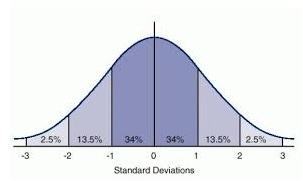
04 "Or" Probabilities for Statistics
Quiz
•
Mathematics
•
9th Grade
•
Hard
Standards-aligned

Matthew Kilgore
Used 4+ times
FREE Resource
20 questions
Show all answers
1.
MULTIPLE CHOICE QUESTION
15 mins • 1 pt
P(A or B) =
P(A) + P(B) - P(A and B)
P(A) + P(B)
P(A)∙P(B|A)
P(A)∙P(B)
2.
MULTIPLE CHOICE QUESTION
15 mins • 1 pt
When does P(A or B) = P(A) + P(B) ?
Always
Never
When A and B are disjoint in relation
When A and B are overlapping in relation
3.
MULTIPLE SELECT QUESTION
15 mins • 1 pt
If two Events A and B are disjoint in relation, which of the following are necessarily true?
P(A or B) = P(A) + P(B)
P(A and B) = 0
P(A and B) = 1
P(A and B) = P(A)∙P(B)
4.
MULTIPLE CHOICE QUESTION
15 mins • 1 pt
Two Events are disjoint in relation when they have...
No outcomes in common
Exactly one outcome in common
At least one outcome in common
All outcomes in common
5.
MULTIPLE CHOICE QUESTION
15 mins • 1 pt
Two Events are overlapping in relation when they have...
No outcomes in common
Exactly one outcome in common
At least one outcome in common
All outcomes in common
6.
MULTIPLE CHOICE QUESTION
15 mins • 1 pt
In the Addition Rule, why do we subtract P(A and B)?
Because some outcomes were counted twice
Because the outcomes in the middle shouldn't count
Because "or" in Statistics means "exclusive or."
Because the common outcomes have a lower weight
7.
MULTIPLE CHOICE QUESTION
15 mins • 1 pt

If a person is selected at random from the people described by the table shown, what is the probability they will be a boy or have brown hair?
70%
95%
25%
68.5%
Create a free account and access millions of resources
Similar Resources on Wayground

15 questions
Probability
Quiz
•
9th - 10th Grade

15 questions
Independent and Dependent Probability
Quiz
•
9th Grade

20 questions
Identifying Independent Dependent Probability
Quiz
•
7th Grade - University

20 questions
Probability and Replacement
Quiz
•
7th Grade - University

15 questions
Choosing Dependent or Independent Probability
Quiz
•
7th Grade - University

20 questions
Joint Marginal and Conditional Relative Frequency with Percents
Quiz
•
9th Grade - University

16 questions
Solving for Variables in Formulas
Quiz
•
8th - 10th Grade

20 questions
Compound Events Dependent
Quiz
•
7th Grade - University
Popular Resources on Wayground

10 questions
Lab Safety Procedures and Guidelines
Interactive video
•
6th - 10th Grade

10 questions
Nouns, nouns, nouns
Quiz
•
3rd Grade

10 questions
9/11 Experience and Reflections
Interactive video
•
10th - 12th Grade

25 questions
Multiplication Facts
Quiz
•
5th Grade

11 questions
All about me
Quiz
•
Professional Development

22 questions
Adding Integers
Quiz
•
6th Grade

15 questions
Subtracting Integers
Quiz
•
7th Grade

9 questions
Tips & Tricks
Lesson
•
6th - 8th Grade
Discover more resources for Mathematics

12 questions
Graphing Inequalities on a Number Line
Quiz
•
9th Grade

15 questions
Two Step Equations
Quiz
•
9th Grade

12 questions
Absolute Value Equations
Quiz
•
9th Grade

15 questions
Combine Like Terms and Distributive Property
Quiz
•
8th - 9th Grade

20 questions
Transformations of Functions
Quiz
•
9th Grade

20 questions
Multi-Step Equations and Variables on Both Sides
Quiz
•
9th - 12th Grade

10 questions
Literal Equations
Quiz
•
9th Grade

10 questions
Solving Absolute Value Equations
Quiz
•
8th - 9th Grade


